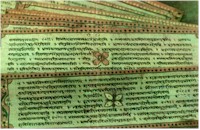|
ASSAM..... Journey to the Green Land
Festivals
Arts and Handicraft
Religion

|
| Old Vasnavite manuscript written on tree bark with locally prepared ink. |
The embryo of Assamese literature can be traced back to the 7th Century aphorisms
of Dak. However, there is no written specimen from this period. That was the time of literature practised
by way of the spoken word, of folk songs and folk tales, aphorisms, and mantras and tantras (religious hymns).
Though scholars like Banikanta Kakati found traces of the Assamese language in songs called Charyyapada composed
by a sect of Buddhist monks, it is nevertheless true that Assamese literature took definite shape only from the later part
of the 13th Century.
In the 14th Century, in what can be termed as the pre-Vaisnavite Period
of Assamese literature, a number of distinguised poets wrote Kavyas (stories in rhyme) drawn mainly from the epics
and some Puranas. Prominent among these poets were Hem Saraswati, Madhab
Kandali and Haribar Bipra.

|
| Mahapurusha Srimanta Sankardeva |
The golden age of Assamese literature is considered to be the Vaisnavite
Period ushered in by Mahapurusha Srimanta Sankardeva the great Vaisnava saint of Assam. Drawing inspiration
from the epics and the Puranas, Srimanta Sankardeva and his deciples such as Madhab Dev and Ram
Saraswati contributed a wealth of myths and legends, plays, spiritual verses and songs to Assamese literature. Dramas
written by Srimanta Sankardeva constitute the first prose form of Assamese literature. This form was then established by Baikunthanath
Bhattadeva.
Assam came under British rule in 1826 and the Assamese mind was influenced
by western thoughts and ideas. American Baptist Missionaries laid the foundation of modern Assamese literature
with translations of Christian literature and publications on Assamese grammar, lexicography, etc. These missionaries published
the first Assamese journal Arunodoi which encouraged vernacular writing to a great extent, and is considered to mark
the beginning of modern Assamese literature. Interestingly enough, starting with the Arunodoi, Assamese literature
has been shaped and reshaped by a number of journals which dominated the literary scene and introduced new trends and characteristics.
Nathan Brown, Miles Bronson, Levi
Nidhi, Anandaram Dhekial Phukan, Gunabhiram Barua, Hem Chandra Barua
and others were the architects of the Arunodoi Age characterized by deep and serious elements. The Jonaki, published
by a group of Assamese students of Calcutta, heralded the Romantic Age of Assamese literature. The stalwarts of this
age were Laksminath Bezbarua, Chandra Kumar Agarwala, Padmanath Gohain Barua
and Hem Chandra Goswami. The Romantic Age continued almost to the beginning of the Second World War with
literateurs such as Raghunath Chowdhury, Nilamoni Phukan (Sr), Jatindranath Dowerah,
Ambikagiri Raichowdhury, Banikanta Kakati, Dimbeswar Neog, Deba
Kanta Baruah and Nalini Bala Devi sustaining the trend.

|
| Jyoti Prasad Agarwalla |
The impact of the Second World War and intensification of the Independence
Movement served to usher in an era of realistic writings. Leftist ideology and Freudian psychology are other discernible elements
of the writings of the time. The multi-faceted Jyoti Prasad Agarwalla who was a dramatist, lyricist, musician,
writer, poet, artist and cinema-maker all rolled into one, and had started his literary career before the War, went on to
make significant contributions to Assamese drama and music in this period.
Amulya Barua, Kalaguru Bishnu Rabha, Phani Sharma, Syed Abdul Malik, Biren
Bhattacharyya, Maheswar Neog, Jogesh Das and Hem Barua were amongst the pioneers of this Age, and many of them continue to
enrich Assamese literature with their writings even today.
|

